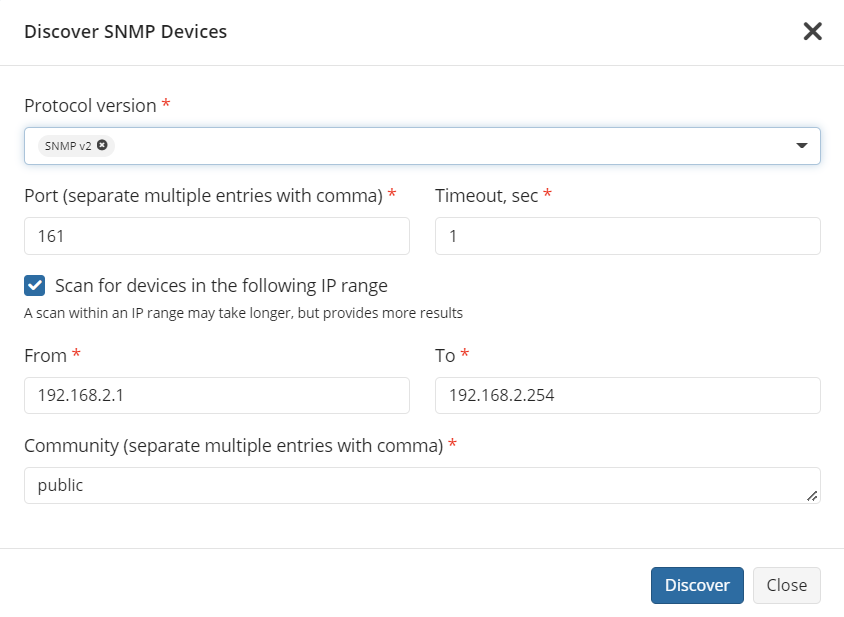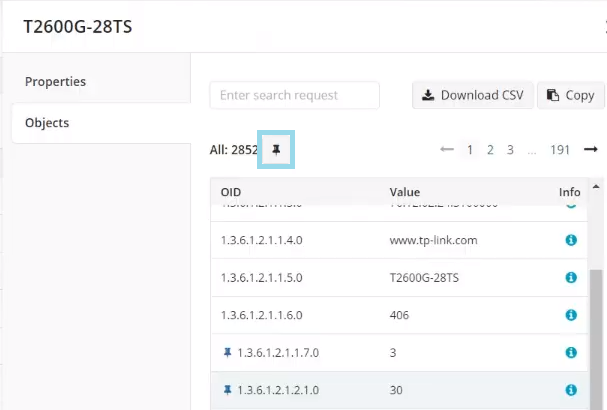SNMP Device Monitoring
With RMM you can monitor your network environment including devices working on SNMP protocols.
This chapter covers the following topics:
How It Works
Supported SNMP Protocol Versions
RMM supports the following SNMP protocol versions:
- SNMP v1
- SNMP v2
- SNMP v3
Get familiar with the basic principles of working with SNMP using RMM. RMM discovers SNMP devices automatically, despite the device discovery procedure being started manually by an administrator. The automatic discovery creates a number of sensors for all devices found in a network. The first discovery is executed as you click Discover SNMP Devices

The device list is displayed after the search is finished.
The scanning consist of three stages:
- A network segment is scanned for new devices using a ping
- Assess the device type for all devices discovered in step 1 (via the Simple Network Management Protocol (SNMP), Windows Management Instrumentation (WMI), and other protocols).
- Sensor sets matching the discovered device types are created
| Top |
Scan The Network
To scan the network for new devices, proceed as follows:
- Open Management Console.
- On Computers select Remote Management if you use legacy main menu, or open RMM > Computers page in the new main menu.
- Find the required computer, in the RMM column, click Show RMM Info.
- At the bottom of the pane, click SNMP (Beta).
- Click Discover New Devices.

- Select the search options and start the search. The search options vary for different SNMP protocol versions:
- SNMP protocol version
- SNMP authentication data
- IP address range
- UDP ports
- Timeout
- Community

- When scanning a network, the SNMP agent requests network devices and collects their data.
- All responded devices are displayed in a single table:
- If a response from the device succeeded, its characteristics are displayed in the table
- If a response did not succeed, a user is prompted to authenticate
SNMP Devices can be of various types. For example:
- Computers with SNMP enabled
- Printers
- Network infrastructure devices (routers, switches, etc.)
- Network storage (NAS)
- Virtual machines
If a device type is defined, it is displayed in the SNMP device table.
| Top |
Hide Devices
You can hide unnecessary devices from the device list. To do this, proceed as follows:
- Open Management Console.
- On Computers select Remote Management if you use legacy main menu, or open RMM > Computers page in the new main menu.
- Find the required computer, in the RMM column, click Show RMM Info.
- At the bottom of the pane, click SNMP (Beta).
- Find the required device, click ... to the right.
- Select Hide.
| Top |
Unhide Devices
You can get back hidden devices to the SNMP devices list. To do this, proceed as follows:
- Open Management Console.
- In the Computers menu, select Remote Management.
- Find the required computer, in the RMM column, click Show RMM Info.
- At the bottom of the pane, click SNMP (Beta).
- Switch to the Hidden.
- Find the required device, click ... to the right.

- Select Unhide.
| Top |
View and Pin Device Details
You can open detailed information about the SNMP device, see all OIDs of this device and their values.
To view the device OIDs, proceed as follows:
- Open Management Console.
- On RMM > SNMP Monitoring page in the new main menu.
- Find the required device, click on the device name to see the properties on Properties tab.

You can select required OIDs on Objects tab, select and pin them.

Them you can see pinned objects in Pinned Devices on Properties tab.
The information on previously discovered devices will be automatically updated using periodic requests.
| Top |